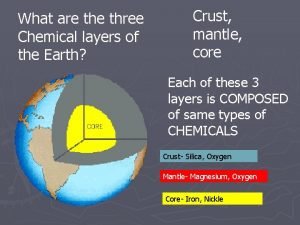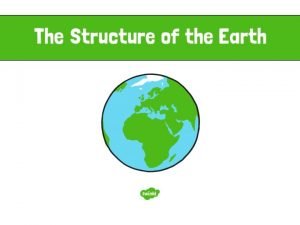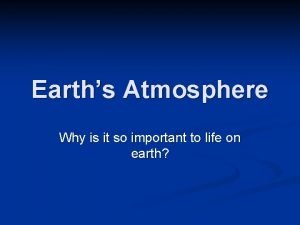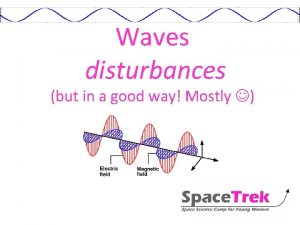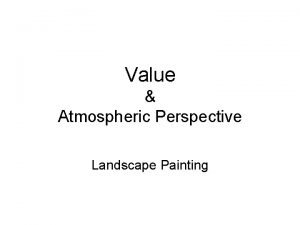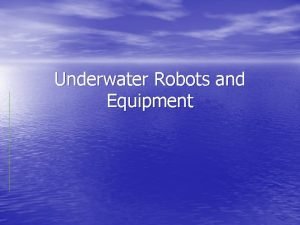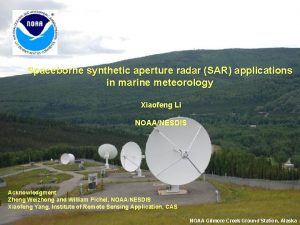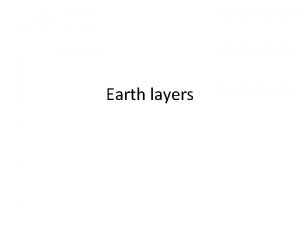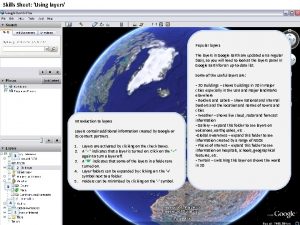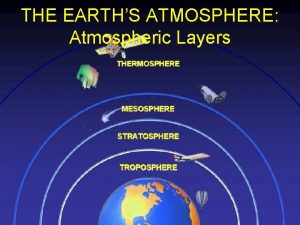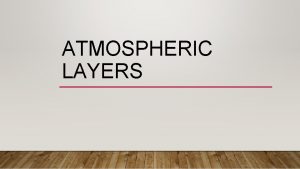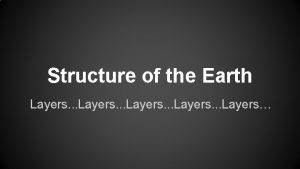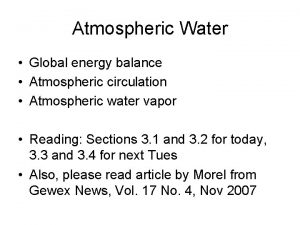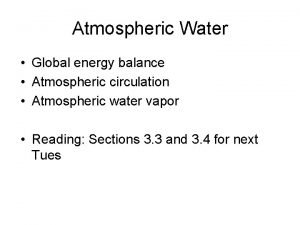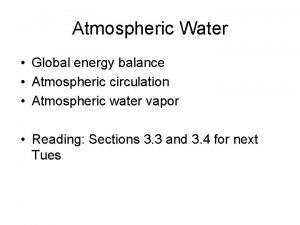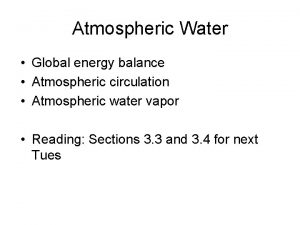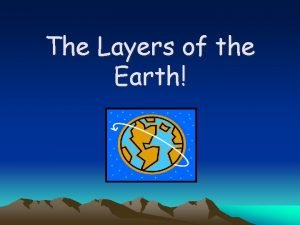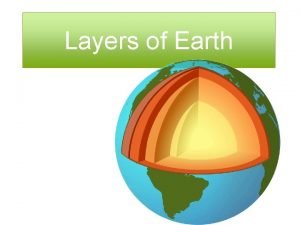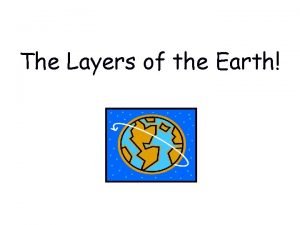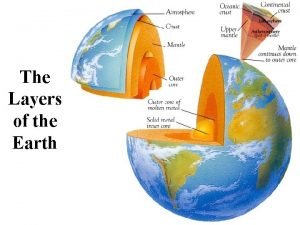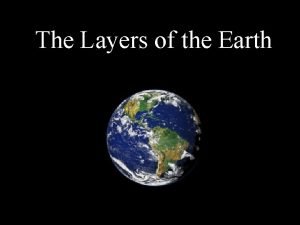Atmospheric Structure Atmospheric Structure Five Layers of the
























































- Slides: 56

Atmospheric Structure

Atmospheric Structure Five Layers of the Atmosphere Exosphere 350 km - ∞ 80 km ( 250, 000 feet ). ( approx. 48 miles ) 47 km ( 150, 000 feet ). (approx. 28 miles) 12 km ( 38, 000 feet ). ( approx. 7 miles ) Exosphere 0 km ( 0 feet )


Atmospheric Structure : General Trends Going Upward Through the Atmosphere

Temperature Changes The temperature rises again as you rise through thermosphere. However, the air is very thin up here! The temperature drops again as you rise through the mesosphere. The temperature rises as you rise through the stratosphere. The temperature drops as you rise through the troposphere.

Changes in Temperature & Chemical Composition with Increasing Altitude NO+ O 2 N 2 O 2 absorbs solar radiation NO+ Temp drops through the mesosphere. N 2 O 2 to warm thermosphere. O 3 N 2 O 2 Ar CO 2 H 2 O Sunlight warms Earth’s surface and lower troposphere

Changes in Pressure and % Mass with Increasing Altitude Exosphere 10% drop in pressure 1 % of mass in at each new stage mesosphere, going upward thermosphere and exosphere combined. 001 mb 0. 1 mb 1. 0 mb 1000 mb About 19 % of mass in stratosphere 80% of mass in troposphere

Atmospheric Structure : Layer by Layer

The Lower Layers of the Atmosphere : Troposphere and Stratosphere

IA. Troposphere (0 – 12 km (38, 000 feet) is the home of almost all of our weather:

IA. Troposphere Most cloud activity is limited to the troposphere, where low-lying stratus and fluffy cumulus clouds are found.

Troposphere Clouds low-lying stratus and fluffy cumulus clouds Cumulus Stratus

Troposphere Clouds Stratocumulus – a combination of layered and puffy (common near oceans). Stratocumulus

Troposphere Clouds When stratus clouds reach down to ground level, they become fog.

IA. Troposphere The troposphere is thicker at the equator than at the poles.

IA 2. Jet Stream (12 km) Flowing along the top of the weather systems of the troposphere are the river-like jet streams.

IA 2. Jet Streams These upper level winds travel in a generally west to east direction at speeds of up to 1 9 0 miles per hour!

IA 2. Jet Streams The jet streams are “sandwiched” between the troposphere and the stratosphere. Stratosphere Troposphere

IA 2. Jet Streams There are two main jet streams in North America: Polar Jet Stream – rides along the edge of the polar air mass

IA 2. 2) Jet Streams The Sub-Tropical Jet Stream is a little less changeable and usually flows from west to east across Mexico and the southern United States.

IA 2. 2) Jet Streams Polar Jet Tropical Jet

IA 2. 2) Jet Streams Watch out when they merge or come close and then diverge! Diverging Jet Streams Merging Jet Streams The result will be severe weather: snow storms, thunderstorms or even tornadoes.

IA 2. 2) Jet Streams Polar Jet Upper Air Divergence Tropical Jet

Polar and Tropical Jet Stream Movement over a 5 Day Period

Tornadoes

Hurricanes

Mid-Level Clouds The upper troposphere is home to midlevel clouds such as: a) altocumulus

Mid-Level Clouds The upper troposphere is home to midlevel clouds such as: a) altostratus

IB. Stratosphere (12 – 47 km (150, 000 feet) the calm, clear layer directly above the troposphere.

Stratospheric Clouds The stratosphere only contains cirrus clouds, which are made of tiny ice crystals.

Stratospheric Clouds • Cirrocumulus Other stratospheric (high altitude) clouds. Notice the “cirro - ” prefix. • Cirrostratus (note the halo. )

Stratospheric Clouds Towering cumulonimbus thunderheads start out in the troposphere, but quickly grow and punch a hole into the stratosphere.

Stratospheric Clouds Cumulonimbus thunderheads From above… Developing thunderhead From below…

Polar Stratospheric Clouds Nacreous Clouds

“What on Earth is nacre? ? ”, I hear you ask. . Nacre is the colorful “mother of pearl” lining found on the inside of abalone and oyster shells. Somebody decided that the iridescent colors of nacreous clouds resembled the colors seen in these nacre shell linings.

Ozone Layer The stratosphere is also home to the ozone layer (20 – 47 km). The ozone layer gets depleted more during some years than it does during others. In 2003, the second worst “ozone hole” ever recorded was measured:

Ozone – O 3 Side Note: the ozone molecule consists of three oxygen atoms held together by covalent bonds. The ozone layer also causes the surprising warming of the air that occurs while rising upward through the upper stratosphere.

The Middle Layers of the Atmosphere : Mesosphere and Thermosphere

IC. Mesosphere (47 – 80 km (250, 000 feet) The mesosphere is the middle layer of the atmosphere. Air temperatures starts to get colder again with increasing altitude. Air temperature drops to – 90 o C at the top of the mesosphere.

IC. Mesosphere The most distinctive Meteors features of the mesosphere are the meteors (“shooting stars”) which blaze across the sky as they burn up when the atmosphere grows denser. Meteorite

Polar Mesospheric Clouds Noctilucent clouds form WAAYYY up (250, 000 feet up) in the mesosphere, where water condenses onto “meteor smoke”!!

ID. Thermosphere/Ionosphere (80 – 350 km*) The ionosphere is full of charged particles ( ions ) and is found in the lower part of thermosphere. The ionosphere is the layer of the atmosphere which interacts with the solar wind to create the Northern Lights: ( Aurora borealis ) and Southern Lights ( Aurora australis ). (*up to 500 – 600 km during “Solar Max”)


The Upper Layers of the Atmosphere : Thermosphere and Exosphere 350 km

Thermosphere And Exosphere International Space Station (Thermosphere) Thermosphere Auroras (Thermosphere) Noctilucent Clouds and Meteors (Mesosphere)

IE. Exosphere (350 km* - ? ? ? ) At the outermost edge of thermosphere is the exosphere, which continues until it merges with the interplanetary gases of outer space. The exosphere is primarily made of Hydrogen and Helium, like most of the rest of the universe. (*The lower edge, called the exobase, can be as high as 500 – 600 km during a Solar

IE. Exosphere The tallest clouds poke into the stratosphere. Above them lie the dark recesses of the exosphere and outer space. ( Moon is in the distance. ) Show Globallift Video Now

IE 2. Magnetosphere Extending far above earth is the invisible magnetosphere, or magnetic field of Earth. It is not part of Earth’s atmosphere. However, it connects and interacts with the Sun’s magnetic field and deflects the particles of the solar wind toward the magnetic north and south poles.

IE 2. Magnetosphere That is why the auroras are usually found up near the Arctic Circle in North America and Europe. P. S. – The aurora near the South Pole is called the Aurora australis : the “Southern Lights”.

Earth’s Magnetosphere Solar Wind

Atmospheric Structure

EXOSPHERE IONOSPHERE LAYER NACREOUS CLOUDS Jet Stream



IA 2. 2) Jet Streams New York Los Angeles

 Atmosphere definition
Atmosphere definition What are the three chemical layers of earth
What are the three chemical layers of earth Galea of scalp
Galea of scalp Suboccipital venous plexus
Suboccipital venous plexus 5 layers of neurosis
5 layers of neurosis Five layers of the earth
Five layers of the earth Levels of atmosphere
Levels of atmosphere And all its aching joys are now no more
And all its aching joys are now no more Five of five
Five of five 5 elements and 5 senses
5 elements and 5 senses Macbeth act five scene one
Macbeth act five scene one Hát kết hợp bộ gõ cơ thể
Hát kết hợp bộ gõ cơ thể Frameset trong html5
Frameset trong html5 Bổ thể
Bổ thể Tỉ lệ cơ thể trẻ em
Tỉ lệ cơ thể trẻ em Voi kéo gỗ như thế nào
Voi kéo gỗ như thế nào Chụp tư thế worms-breton
Chụp tư thế worms-breton Chúa yêu trần thế alleluia
Chúa yêu trần thế alleluia Môn thể thao bắt đầu bằng chữ đua
Môn thể thao bắt đầu bằng chữ đua Thế nào là hệ số cao nhất
Thế nào là hệ số cao nhất Các châu lục và đại dương trên thế giới
Các châu lục và đại dương trên thế giới Cong thức tính động năng
Cong thức tính động năng Trời xanh đây là của chúng ta thể thơ
Trời xanh đây là của chúng ta thể thơ Cách giải mật thư tọa độ
Cách giải mật thư tọa độ 101012 bằng
101012 bằng Phản ứng thế ankan
Phản ứng thế ankan Các châu lục và đại dương trên thế giới
Các châu lục và đại dương trên thế giới Thể thơ truyền thống
Thể thơ truyền thống Quá trình desamine hóa có thể tạo ra
Quá trình desamine hóa có thể tạo ra Một số thể thơ truyền thống
Một số thể thơ truyền thống Cái miệng bé xinh thế chỉ nói điều hay thôi
Cái miệng bé xinh thế chỉ nói điều hay thôi Vẽ hình chiếu vuông góc của vật thể sau
Vẽ hình chiếu vuông góc của vật thể sau Thế nào là sự mỏi cơ
Thế nào là sự mỏi cơ đặc điểm cơ thể của người tối cổ
đặc điểm cơ thể của người tối cổ Thứ tự các dấu thăng giáng ở hóa biểu
Thứ tự các dấu thăng giáng ở hóa biểu Vẽ hình chiếu đứng bằng cạnh của vật thể
Vẽ hình chiếu đứng bằng cạnh của vật thể Tia chieu sa te
Tia chieu sa te Thẻ vin
Thẻ vin đại từ thay thế
đại từ thay thế điện thế nghỉ
điện thế nghỉ Tư thế ngồi viết
Tư thế ngồi viết Diễn thế sinh thái là
Diễn thế sinh thái là Dot
Dot Các số nguyên tố
Các số nguyên tố Tư thế ngồi viết
Tư thế ngồi viết Lời thề hippocrates
Lời thề hippocrates Thiếu nhi thế giới liên hoan
Thiếu nhi thế giới liên hoan ưu thế lai là gì
ưu thế lai là gì Khi nào hổ mẹ dạy hổ con săn mồi
Khi nào hổ mẹ dạy hổ con săn mồi Khi nào hổ mẹ dạy hổ con săn mồi
Khi nào hổ mẹ dạy hổ con săn mồi Hệ hô hấp
Hệ hô hấp Từ ngữ thể hiện lòng nhân hậu
Từ ngữ thể hiện lòng nhân hậu Thế nào là mạng điện lắp đặt kiểu nổi
Thế nào là mạng điện lắp đặt kiểu nổi Atmospheric opacity
Atmospheric opacity Atmospheric perspective watercolor
Atmospheric perspective watercolor Atmospheric suits
Atmospheric suits Atmospheric gravity waves
Atmospheric gravity waves

